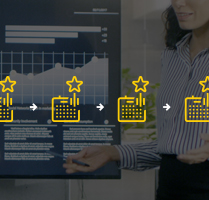
No matter the scale of the enterprise or the diversity of location, one thing remains constant: the importance of an inspired and engaged sales team. Employee sales incentive programs promote a culture of recognition and reward, ensuring that hard work and dedication resonate across all corners of the organization.
Understanding sales incentive program objectives, advantages, and potential drawbacks is critical to crafting a strategy that truly resonates with employees.
This article explores how sales incentive programs shape company culture, raise drive, and foster success.
What are sales incentive programs?
Sales incentive programs motivate and reward sales teams for hitting specific targets. They aim to boost sales, improve market share, raise product awareness, enhance customer satisfaction, and build team spirit.
These programs set targets such as revenue goals and new customer acquisitions, offering financial incentives (like bonuses or gift cards) and non-financial incentives (from recognition to travel). Programs can be short-term or long-term, rewarding individual achievements, team efforts, or different levels of accomplishments.
What is the most common form of incentive for salespeople?
There are multiple ways to inspire salespeople successfully. While salaries and hourly wages provide stability and initial drive, options like commissions and bonuses directly tie earnings to performance and maintain steady motivation. For example, commissions, a typical sales incentive, encourage salespeople to close more deals by earning a percentage of their sales.
However, sales incentives go beyond commissions and purely closing deals. Businesses can reward employees for excellent customer interactions, company anniversaries, or a positive work attitude. These non-sales incentives are just as powerful, if not more, in motivating and engaging teams.
Sales incentives include cash and cash equivalents like gift cards, which are popular and effective due to their flexibility and broad appeal. Other popular incentives include travel rewards, recognition awards, high-end merchandise, professional development opportunities, and health and wellness benefits.
What is the objective of a sales incentive program?
The objective of a sales incentive program is to motivate and reward salespeople for achieving specific performance goals. In 2023, only 23 percent of employees strongly agreed that they received adequate recognition for their work. These programs aim to improve that statistic, increase worker happiness, and build a cohesive team. Doing this naturally drives sales and enhances customer satisfaction, too.
What are the advantages of sales incentive programs?
Employee sales incentive programs have a proven track record of success. They offer numerous advantages that support their objectives, grow sales, and provide significant benefits that make their implementation worthwhile.
Increased productivity
Sales incentive programs increase employee engagement by 3.7 percent, leading to substantial gains in productivity and profitability. Engaged employees are more inspired, dedicated, and likely to go above and beyond. This heightened level of engagement translates into better customer interactions, higher sales figures, and improved overall performance.
Reduced employee turnover
These programs also help to recognize and reward high performers, boosting morale and reducing employee turnover. Employees who receive frequent recognition are 68 percent less likely to feel burned out at work.
Lower turnover rates prevent business operations gaps and reduce the costs associated with hiring and training new employees.
Enhanced company culture
A recent study showed 90 percent of employees consider incentive and recognition programs key to building culture and uniting a dispersed workforce.
These programs align individual and team efforts with strategic objectives, ensuring that every branch of the enterprise works cohesively towards common targets, regardless of geographic boundaries.
Constant motivation
Among employees with great recognition experiences, 72 percent say their company frequently recognizes them for small tasks. Acknowledging minor achievements drives additional motivation because the praise is attainable rather than based on extensive goals.
Gift cards are an excellent way to reward workers for small acts. Buying them in bulk saves money and allows companies to reward multiple employees frequently without significant costs. To keep it exciting, vary the stores for the gift cards to ensure the rewards remain fresh and appealing.
What are the disadvantages of sales incentives?
While employee sales incentive programs offer many benefits, they also have potential disadvantages. One risk is they can inadvertently encourage unethical behavior, such as misreporting sales or favoring customers with the highest incentive payouts.
These programs sometimes favor specific departments or locations over others, leading to internal disparities and resentment within the company.
Another issue is some incentives are not universally appealing. If the rewards are only attractive to a small demographic, such as specific merchandise or niche experiences, they can fail to inspire the broader sales team.
Cash incentives, while popular, can also have drawbacks. Over time, they may be viewed as part of regular income, diminishing their influence. Employees might come to expect these bonuses, which can reduce the sense of competition and make the rewards feel less meaningful.
In contrast, gift cards often feel more symbolic and valuable. They provide a tangible reward that stands out more than just extra numbers on a paycheck. For large companies, bulk gift cards are also the most flexible option, allowing employees to pick what suits them best—making them appealing to all.
Conclusion: Upgrade your sales incentive program
In this thorough exploration of sales incentive programs, we’ve uncovered their various aspects, from objectives and advantages to potential cons. These programs serve as powerful tools to excite and reward sales teams, driving productivity, reducing turnover, and fostering a positive company culture.
One standout incentive option highlighted is gift cards, which offer flexibility and broad appeal. Gift cards provide tangible rewards that feel more symbolic and valuable than cash bonuses, making them an excellent choice for incentivizing sales teams.
As enterprises and multi-location organizations strive to enhance their incentive strategies, NeoCurrency offers a solution tailored to their needs. With access to over 2000 brands across 60 countries, NeoCurrency provides unparalleled flexibility and choice for rewarding sales teams.
Request a demo today to discover how NeoCurrency can help your sales team thrive with innovative incentive solutions.



